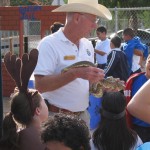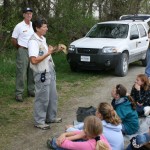“When my friend was at a reptile program, they hung a snake around his neck,” a second grader told us during one of our school programs recently. “When the snake started to curl around his neck, the owner said he’d take it off when my friend’s face started to turn purple.”

Toward the end of this program, we had just removed our five-foot bullsnake from its carrier and discussed what a constrictor is. “How many of you think it would be really cool to hang this snake around your neck?” we asked. Generally when we ask that question, half the class raise their hands and the teacher cringes.
Injuries and Death
And we cringe as well. We’ve attended reptile programs that delivered excellent information about snakes and other reptiles, but many of these programs end with touch and picture time, often with a snake dangling from a visitor’s neck. Despite the fact that this theatrical act shows a lack of respect for the animal, a snake even the size of our bullsnake could injure or even kill a young child. And larger snakes have injured and killed adults.
Not many years ago in Denver, an 11-foot Burmese python killed its owner when placed around the man’s neck. Labeled a “bad” snake, authorities destroyed the animal. But a snake is neither “good” nor “bad.” It is merely a snake and it does what snakes do. In this case, with nothing but its body to hold on with, the python tightened around the neck to prevent itself from falling.
Invitation
Recently, we were encouraged to join an organization that dedicates itself to reptile education. Interested, we checked their website and discovered several pictures of visitors’ children sporting large snakes around their necks. Since this is contrary to the message we deliver, we declined the invitation.

Snakes, as well as other animals, are not toys or playthings. Since snakes are not fond of being touched and handled, we limit our snakes’ encounters with the public. We rarely allow children to hold them; and when they touch a snake, we require that they use only two fingers to gently stroke the snake’s back in the direction that the scales lay. “And stay away from the head,” we insist.
First Feel
Many children have never before touched a snake. Their eyes light up with the first contact. “It’s dry!” some say. “It’s soft!” “It feels like rubber!” “It feels like a quilt!”
With this introduction, we hope to instill a respect for these misunderstood and feared animals. We don’t expect everyone to love snakes, but merely to value them as part of the natural world.
And we definitely discourage using them for a necklace!
